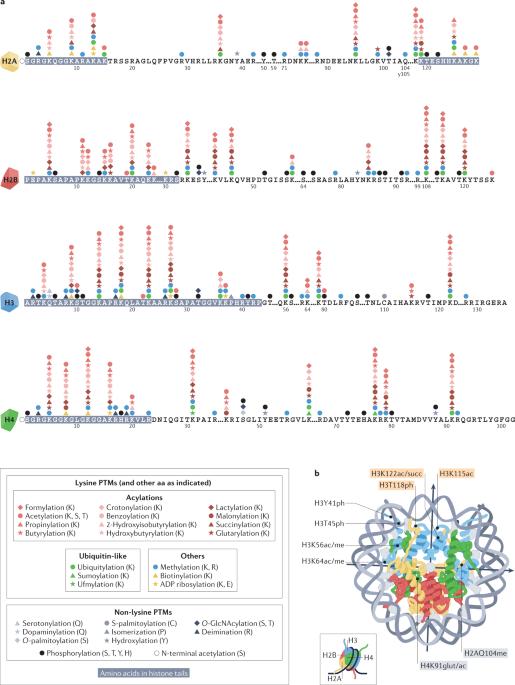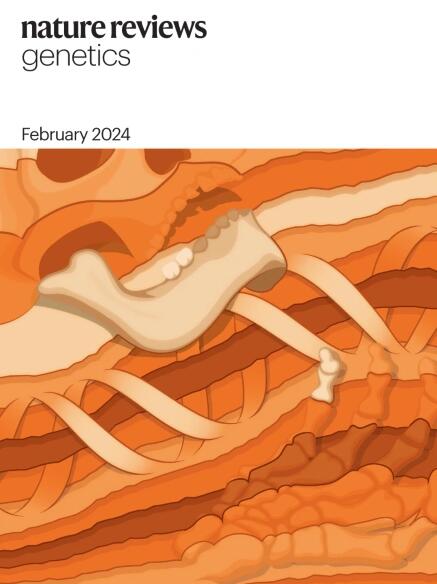Histone post-translational modifications — cause and consequence of genome function
IF 52
1区 生物学
Q1 GENETICS & HEREDITY
引用次数: 154
Abstract
Much has been learned since the early 1960s about histone post-translational modifications (PTMs) and how they affect DNA-templated processes at the molecular level. This understanding has been bolstered in the past decade by the identification of new types of histone PTM, the advent of new genome-wide mapping approaches and methods to deposit or remove PTMs in a locally and temporally controlled manner. Now, with the availability of vast amounts of data across various biological systems, the functional role of PTMs in important processes (such as transcription, recombination, replication, DNA repair and the modulation of genomic architecture) is slowly emerging. This Review explores the contribution of histone PTMs to the regulation of genome function by discussing when these modifications play a causative (or instructive) role in DNA-templated processes and when they are deposited as a consequence of such processes, to reinforce and record the event. Important advances in the field showing that histone PTMs can exert both direct and indirect effects on genome function are also presented. Histone post-translational modifications (PTMs) have been mainly regarded as instructing DNA-templated processes. In this Review, Gonzalo Millán-Zambrano and colleagues describe how histone PTMs both affect and are affected by these DNA processes and should be viewed as components of a complex genome-regulating network.

组蛋白翻译后修饰--基因组功能的原因和结果
自 20 世纪 60 年代初以来,人们已经对组蛋白翻译后修饰(PTM)及其如何在分子水平上影响 DNA 引发的过程有了很多了解。过去十年中,新型组蛋白 PTM 的鉴定、新的全基因组图谱绘制方法的出现以及以局部和时间控制的方式沉积或移除 PTM 的方法,进一步加深了人们对这一问题的认识。现在,随着各种生物系统中大量数据的出现,PTM 在重要过程(如转录、重组、复制、DNA 修复和基因组结构调控)中的功能作用正慢慢浮出水面。本综述探讨了组蛋白 PTM 对基因组功能调控的贡献,讨论了这些修饰何时在 DNA 引发的过程中发挥因果(或指导)作用,何时作为这些过程的结果沉积下来,以加强和记录这一事件。本研究还介绍了该领域的重要进展,这些进展表明组蛋白 PTM 可对基因组功能产生直接和间接的影响。组蛋白翻译后修饰(PTMs)主要被认为是指示 DNA 引发的过程。在这篇综述中,Gonzalo Millán-Zambrano 及其同事描述了组蛋白 PTM 如何既影响 DNA 过程,又受这些 DNA 过程的影响,并应将其视为复杂的基因组调控网络的组成部分。
本文章由计算机程序翻译,如有差异,请以英文原文为准。
求助全文
约1分钟内获得全文
求助全文
来源期刊

Nature Reviews Genetics
生物-遗传学
CiteScore
57.40
自引率
0.50%
发文量
113
审稿时长
6-12 weeks
期刊介绍:
At Nature Reviews Genetics, our goal is to be the leading source of reviews and commentaries for the scientific communities we serve. We are dedicated to publishing authoritative articles that are easily accessible to our readers. We believe in enhancing our articles with clear and understandable figures, tables, and other display items. Our aim is to provide an unparalleled service to authors, referees, and readers, and we are committed to maximizing the usefulness and impact of each article we publish.
Within our journal, we publish a range of content including Research Highlights, Comments, Reviews, and Perspectives that are relevant to geneticists and genomicists. With our broad scope, we ensure that the articles we publish reach the widest possible audience.
As part of the Nature Reviews portfolio of journals, we strive to uphold the high standards and reputation associated with this esteemed collection of publications.
 求助内容:
求助内容: 应助结果提醒方式:
应助结果提醒方式:


